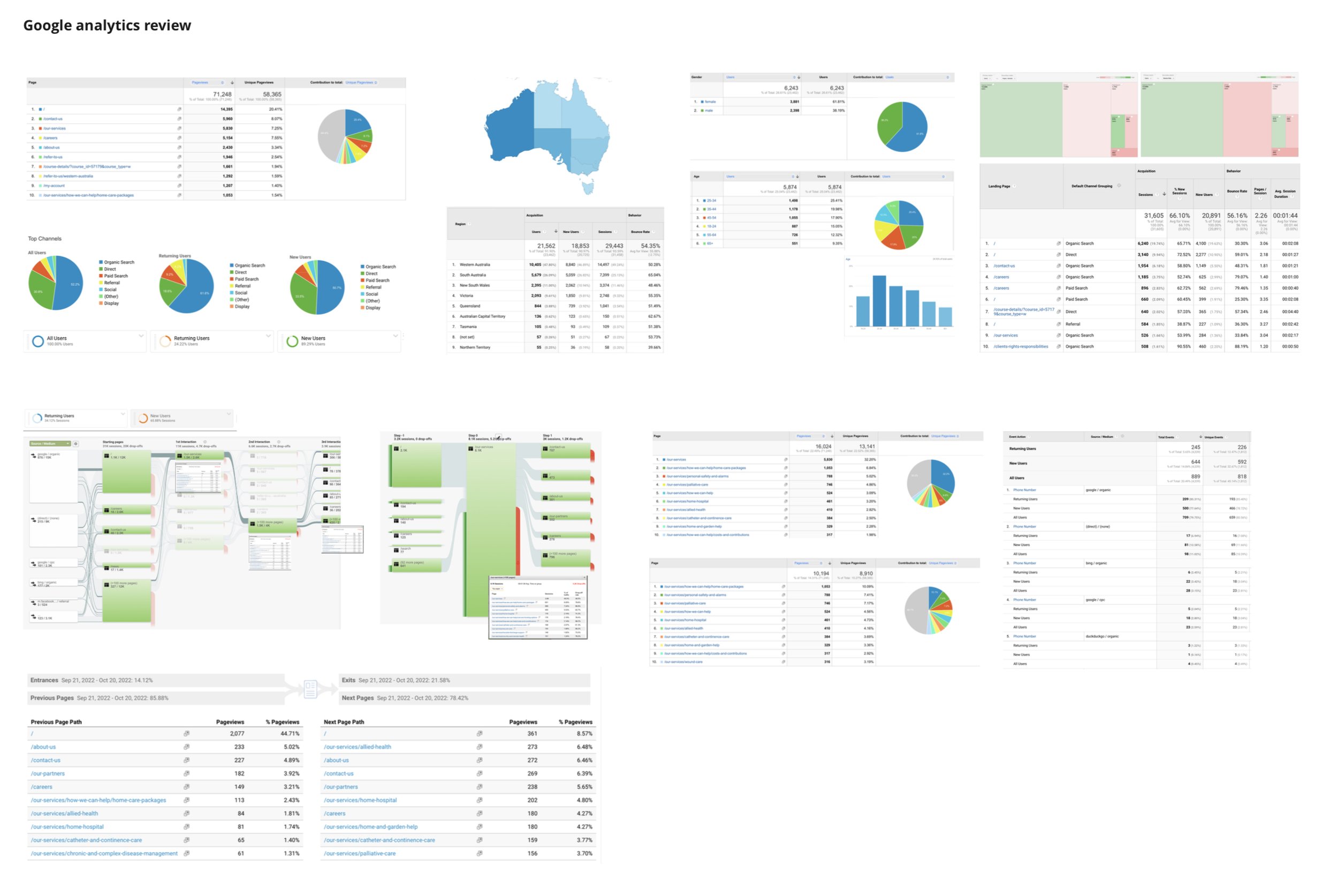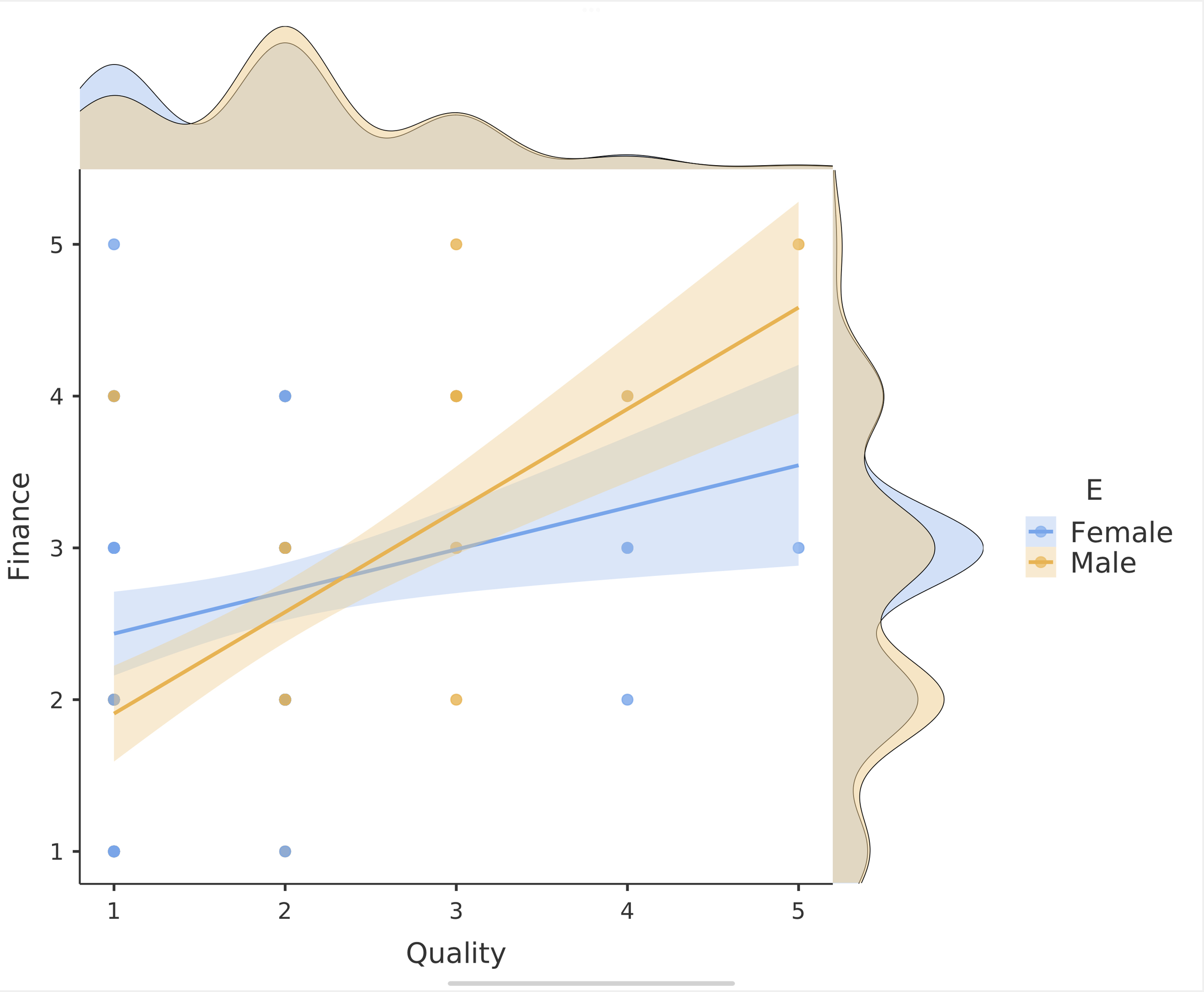Silver Chain
Enhancing Silver Chain's In-Home Services through Statistical Analysis and Intelligent Information Architecture
This case study delves into the transformative journey of Silver Chain's In-Home Care Services, where user navigation and information architecture underwent a remarkable revamp. By harnessing the power of Cluster Analysis and leveraging intelligent information architecture, Silver Chain elevated their care experiences to new heights. Through a deep understanding of user segments, Silver Chain implemented strategic improvements that catered to the unique needs and preferences of their diverse user base.
Introduction
Silver Chain is the leading provider of comprehensive in-home care services in Australia, supporting over 100,000 people annually across various care categories such as in-house hospital care, palliative care, aged care (Home Care Packages and Commonwealth Home Support Programme), allied health and social support, and virtual care monitoring.
To ensure a seamless and user-centric digital experience for their clients, caregivers, and healthcare professionals, Silver Chain embarked on an extensive Information Architecture (IA) project. This multifaceted project was designed to refine and optimise their digital presence, and it was structured into four distinct phases:
Current State Analysis
Proto-Personas and Customer Journeys
Customer Profiles
Information architecture design and testing
1. Current State Analysis
An analysis of Silver Chain's existing digital presence was conducted, including traffic and user flow from primary digital channels, search keyword analysis (SEO), content audit, and page performance analysis. Data from Google Analytics provided valuable insights into user behaviour and preferences.
An in-page survey collected information from website visitors, including existing and potential clients, healthcare professionals, carers, and job seekers. It also gathered reasons for visiting the website, such as booking appointments, seeking service or fee information, finding contact details, and exploring job opportunities.
Additionally, a competitor analysis and heuristic review of the current IA was conducted to identify usability issues and areas for improvement.
2. Proto-Personas and Customer Research
During the initial stakeholder workshop, we identified nine proto-persona profiles by combining insights from the website's behavioural data and competitor analysis. These proto-personas were based on household composition, cultural and social characteristics, age in relation to eligibility for government funds, and specific health conditions and care needs.
Proto-personas served as valuable tools for interview recruitment (screening) and script development, providing a common framework to align insights from qualitative and quantitative phases.
Customer Research
The research aims to explore the Consumer audience in depth to generate detailed insights and develop valid consumer clusters. Additionally, a significant focus is on conducting correlation and regression analyses to understand the relationship between various factors and inform the creation of a new Information Architecture (IA) for the website.
Due to the researcher's limited familiarity with the problem space and existing research, we opted for a Mixed Methods Research approach, with a qualitative phase preceding the quantitative phase.
Qualitative Phase
The qualitative phase involved user interviews to familiarize ourselves with the subject's perspective. This ethnographic research technique aimed to uncover our target audience's motivations, concerns, and experiences. Interviews were flexible, allowing participants to co-construct the narrative and aid in understanding their journey.
Twenty-three individuals across four key segments were interviewed to uncover insights, needs, and pain points. The qualitative findings informed the design of a closed-answer survey for the subsequent quantitative phase.
Quantitative Phase
A survey, based on insights from the qualitative study, aimed to increase the study's validity and prioritise meaningful insights and needs. The quantitative phase aimed to collect data from at least 1,200 completed surveys, representative of the Australian population.
The questionnaire focused on:
Quantify of members within each group by cultural background, household composition, and place of residence (capital city, town, rural area.
Collection of digital channels and device usage insights to inform future digital strategies
Participants' personal experiences as consumers or carers
Previous 12 months' experiences and specific interactions with healthcare providers
MaxDiff
When exploring the participants' personal experiences as consumers or carers, MaxDiff (Maximum Difference Scaling) type of questions has been utilised to unfold what is more important to them and give statistical relevance to the results.
The analysis of MaxDiff data involves advanced statistical techniques that help identify the relative importance of each item based on the frequency of selections as the most and least preferred. This provides valuable insights into the participants' priorities and allows for a more nuanced understanding of their preferences.
The brilliance of Maxdiff lies in its ability to overcome the limitations of traditional rating or ranking scales. Instead of simply asking participants to rank items in order of preference or rate them on a scale, Maxdiff forces respondents to make trade-offs between different items. By making these trade-offs, participants reveal their true preferences, and researchers can gain a deeper understanding of what truly matters to them.
Potential Recall Bias
The questionnaire aimed to minimise potential recall bias and gather comprehensive insights into participants' experiences and decision-making processes.
According to a 2007 article by Norbert Schwarz, he brought attention to a significant discovery in social psychology. He observed that survey respondents tended to concentrate more on their present, situational impressions, rather than delving into their past feelings, which researchers had hoped to analyse in their respective studies.
The participants are asked to answer questions based on the overall experience in the last 12 months followed by questions specific to their last experience with a healthcare provider. The two sets of questionnaire tries to potential bias on the way the participation recall their experiences and build options in their mind.
Survey respondents were likelier to focus on their current, situational impressions, despite researchers hoping to analyse past feelings (in their respective studies).
- Cognitive Aspects of Survey Methodology, Norbert Schwarz (2017)
Sampling
To ensure a statistically valid sample, participants aged between 18 and 80 were recruited from SurveyMonkey's Australian panel. The sample was capped at 49.3% male and 50.7% female and weighted using demographic data (age and gender) from the ABS Census 2016.
Statistical Analysis
Descriptive analysis followed by Cluster Analysis was performed to identify clusters which are not necessarily related to demographic data. Correlation and regression analyses played a crucial role in identifying key factors influencing consumer decisions and website usage patterns.
Cluster analysis involves grouping a set of objects in such a way that objects in the same group (called a cluster) are more similar to each other than to those in other groups (clusters). The primary goal of cluster analysis is to identify inherent structures or patterns in the data, allowing to gain insights into the underlying relationships and associations among the data points.
Results
The research yielded significant insights. For instance, it revealed that the variety of services offered, including community care, is a crucial factor for consumers when choosing a provider, even surpassing competitive prices. This preference is attributed to the ever-changing clinical conditions of consumers, emphasising the importance of transparency and flexibility.
The research revealed that this younger demographic lacks awareness and knowledge regarding funds available beyond age-related care, such as post-hospitalisation care, which are often unclear and not well-understood.
The survey also highlighted that consumers don't necessarily view the provider's offerings as separate clinical and support services but rather prefer a wide range of relevant services catered to their unique situations and conditions.
Understanding the consumer's mental model is essential to creating a user-friendly information architecture for the new website, which has been explored further in the IA design process.
3. Customer Profiles
The interview and survey results were compared, analysed, and consolidated into a comprehensive report. The report contains recommendations regarding web content, marketing communication, and business strategy, which have been shared with various stakeholders in the organisation. The report also included high-level customer journeys with a focus on the digital experience. The customer journeys encompassed six stages: health issue, referral, search and comparison, funding, provider choice, and care management. Throughout the mapping process, we took into account the customer's decision-making process and mental state.
4. Information Architecture (IA) Design and Validation
Combining the findings from the heuristic review with the data from Google Analytics and the survey, a new IA was proposed to enhance the website's user experience and ensure easy access to critical information for Consumers and Carers.
Mental model
When considering various users' mental models, it's evident that people in similar situations may have different thought processes. For example:
Person #1: "I have diabetes, so I need surgery, so I need wound care." Person #2: "I need wound care because I had surgery because I have diabetes."
Both individuals underwent surgery, but Person #1 seeks wound care, while Person #2 may search for diabetes-related information.
In designing the information architecture at the page level and in navigational elements, we've taken into account the user's mental model. The new structure is centred on "Services," which are collections of "Capabilities." A capability can be associated with several services, aligning with the "root cause" described in the user mental model example.
Taxonomy and Site Map
Taking into account our competitors' navigation models and the intricacies of the user's mental model, we've crafted our taxonomy based on a hierarchical structure. This arrangement classifies capabilities into three primary groups: "Care & Support," "Virtual Services," and "Community Support." Under the "Community Support" category, we've gathered services that might not directly target our primary customers, such as healthcare support for the homeless. This deliberate separation provides distinct paths for users, enhancing clarity.
Within the "Care & Support" category, we've further segmented services into two sub-categories: "Clinical Care" and "Home Support." Despite research indicating that customers may not typically differentiate between clinical services like injections performed by physicians and house cleaning services by general staff, we've maintained these sub-categories in the taxonomy.
One significant advantage of maintaining these sub-categories is that it helps in limiting the number of individual items (capabilities) within each sub-section to fewer than seven. This decision aligns with Miller's law, which suggests that people can more easily process and remember information when it's organized in smaller groups.
Additionally, our choice to maintain the separation between clinical and support services is bolstered by insights from competitor analysis. It has been observed that a majority of service providers in our industry also distinguish between clinical and support services. This adheres to Jakob's law, which emphasizes the importance of maintaining familiar patterns to enhance usability.
In summary, while customers may not always differentiate between clinical and support services, our taxonomy's sub-categories serve practical purposes by adhering to principles like Miller's law and Jakob's law. These considerations are essential for ensuring a user-friendly and comprehensible structure within our information architecture.
Regarding the actual website page structure, we've developed dedicated pages for each of the three main categories. These pages introduce users to the respective service category (e.g., "Care & Support") with customized content. Additionally, they offer users the flexibility to delve deeper into sub-category pages ("Clinical Care" and "Home Support") for more detailed information or directly navigate to pages focused on specific capabilities.
Within the capability-specific pages, we strategically include links to related capabilities. For instance, if someone is searching for information about insulin injections for diabetes management, they will find a related capability link to food preparation, acknowledging the holistic nature of healthcare needs. Similarly, the food preparation page will feature links to the insulin injections capability page and other related capabilities such as stoma care, fostering a comprehensive understanding of user needs.
Treejack Testing
To validate the proposed Information Architecture (IA) and its effectiveness in aiding website navigation, we conducted Treejack testing. This method involved presenting participants with the proposed IA and testing their ability to find specific information or complete tasks using the tree structure. The results of the Treejack testing provided valuable data on the clarity and efficiency of the new IA, helping refine its design.
Navigation
After analysing competitors and conducting customer research, we explored various navigational models. Ultimately, we opted for a mega-menu as our solution. This mega-menu presents three key links: "Our services", "Where to start" and "Why us".
When users click on "Our services," it expands to reveal sub-categories and capabilities. This approach provides users with a clear understanding of the service and capability structure without the need to load multiple pages. It allows users to explore from higher-level categories or subcategories, and those seeking specific services or capabilities can easily jump to the relevant page.
"We're to start" is a crucial pathway for customers. As revealed in our research, customers often face challenges navigating the healthcare system. When expanded, this link prominently appears in the primary navigation and offers different pathways based on various healthcare providers and eligibility criteria.
Lastly, considering the research findings, "Why us" is designed to build trust and credibility. However, it's essential to recognize that trust-building is an ongoing process that extends beyond a single section of the website. In fact, the research report includes several recommendations for increasing trust among existing and potential customers via digital platforms.
Prototype Testing in Maze
Once the new navigational model for the Silver Chain website was designed, the next step in the research process involved conducting prototype testing using the Maze platform. Prototype testing is a crucial phase in the UX design process as it allows for the evaluation of the proposed IA in a realistic interactive environment.
Maze is a user testing and usability tool that enables researchers to create interactive prototypes and gather valuable insights from real users' interactions. By using Maze, we were able to assess the effectiveness of the new IA in aiding website navigation, identifying potential usability issues, and gaining valuable feedback from users.
Challenges
Undertaking a project of this scale certainly presented its fair share of challenges. Firstly, it was crucial to align stakeholders with a well-defined and achievable project scope. This approach contrasted with the initial lack of a settled scope that had the potential to expand during project development.
Furthermore, the project involved multiple stakeholders from diverse disciplines. To ensure its success, we adopted a data-driven approach. In the early stages, emphasising the importance of research and validation within the workflow was essential. We engaged stakeholders in ideation workshops to generate research questions and hypotheses for validation. Subsequently, we presented data back to them, ensuring that the project remained in line with user needs and business goals.
Given the data-driven approach, numerous tests needed to be executed. Managing the project budget was another critical aspect. The initial mixed-methods research played a pivotal role in enabling swift and accurate validation sessions, helping us to contain the budget for the validation process.
Conclusion
The research study employed a comprehensive methodology to enhance the understanding of Silver Chain's target audience. Through current state analysis, proto-personas, customer journeys, and customer profiles, valuable insights were gathered to inform Silver Chain's digital strategy, with correlation and regression analyses providing key insights into the relationship between various factors and the creation of a new IA for the website. The research findings, including segmentation, persona profiles, and key insights, will guide the development of targeted strategies and initiatives to meet the diverse needs of Silver Chain's audience.
Related articles
NEXT PROJECT 















